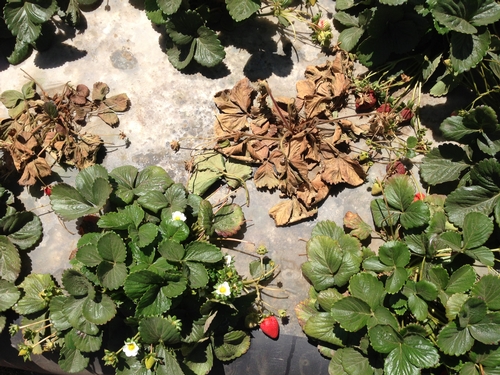Whiteflies are usually considered a minor pest on strawberries, but greenhouse whitefly, Trialeurodes vaporariorum has become an important pest with regular and high infestations in the recent years. Due to the increased concern, I spoke at my recent extension meetings and wrote an article about whiteflies to inform the strawberry industry about potential risks and management options.
High numbers of greenhouse whitefly, Trialeurodes vaporariorum in a Guadalupe strawberry field in March 2013 (above, photo by Surendra Dara) and in November 2012 (below, photo by Lane Stoeckle)
Infestations in different fields in the Santa Maria area varied widely from a few whiteflies here and there to as many as 100 or more per leaflet on many plants in large areas. Heavy infestations of whiteflies cause direct damage to strawberries through their feeding and indirectly through sooty mold development on honeydew secretions. Additionally, whiteflies transmit Strawberry pallidosis associated virus (SPaV) or Beet pseudo yellows virus (BPYV) that contributed to the pallidosis-related decline of strawberries in association with non-whitefly transmitted viruses. Both SPaV or BPYV and other viruses transmitted by aphids, nematodes, or pollen are necessary to cause the pallidosis-related decline of strawberries.
Purple foliage of an affected plant (Photo by Lane Stoeckle, PCA)
A stunted plant among normal plants (Photo by Surendra Dara)
Affected plants eventually die (Photo by Surendra Dara)
Affected area of a field with small, dying or dead plants (Photo by Surendra Dara)
A few fields in the Santa Maria area (cultivar San Andreas) seem to have a problem with dying plants. Stunted plant growth, purple or reddish foliage, and brittle roots which are typical symptoms of pallidosis-related decline of strawberries are seen in the affected fields. These fields also suffered from high whitefly infestations. Preliminary testing of samples at the ARS laboratory in Salinas revealed the presence of SPaV. Additional testing is underway at another ARS laboratory in Corvallis to detect non-whitefly transmitted viruses. Although whitefly history, disease symptoms, and the presence of SPaV suggest pallidosis-related decline, it is necessary to confirm the presence of other viruses.
These incidents emphasize the importance of certain pests especially when they are also vectors of some diseases. Growers should exercise caution in regularly monitoring fields and taking appropriate management decisions to control whiteflies. Suspected plant samples can be sent to our office in San Luis Obispo or to the Ag Commissioner's offices in Santa Barbara County.
Additional information can be found at:
//ucanr.edu/blogs/blogcore/postdetail.cfm?postnum=9167
http://www.ipm.ucdavis.edu/PMG/r734101211.html
http://cesantabarbara.ucanr.edu/files/163916.pdf (Handout in English and Spanish)





